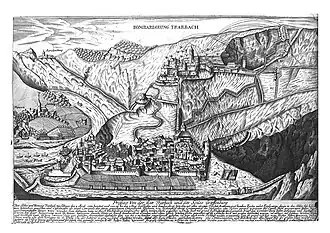Siege of Trarbach
| Siege of Trarbach | |||||||
|---|---|---|---|---|---|---|---|
| Part of the War of the Polish Succession | |||||||
 An engraving depicting the bombardment of Trarbach and the Grevenburg | |||||||
| |||||||
| Belligerents | |||||||
|
|
| ||||||
| Commanders and leaders | |||||||
| Duc de Belle-Isle | Wilhelm Ludwig Freiherr von Hohenfeld[1] | ||||||
| Strength | |||||||
| 20,000 | 700 | ||||||
| Casualties and losses | |||||||
| 200 | 10 | ||||||
The siege of Trarbach (10 April – 2 May 1734) was conducted during the War of the Polish Succession by French troops against a garrison of troops of the Holy Roman Empire in the fortress at Trarbach in the County of Sponheim, a small principality of the Holy Roman Empire (Trarbach is now in Rhineland-Palatinate, Germany). The French, led by Marshal Belle-Isle, were victorious, and destroyed the fortress.
References
- Gfrörer, August. Geschichte des achtzehnten Jahrhunderts, Volume 2 (History of the Eighteenth Century). Hurter, 1862.
- Rooke, Octavius. The life of the Moselle. Booth, 1858.
- Schütz, Ernst. Trarbach in alter Zeit (pp. 144ff)